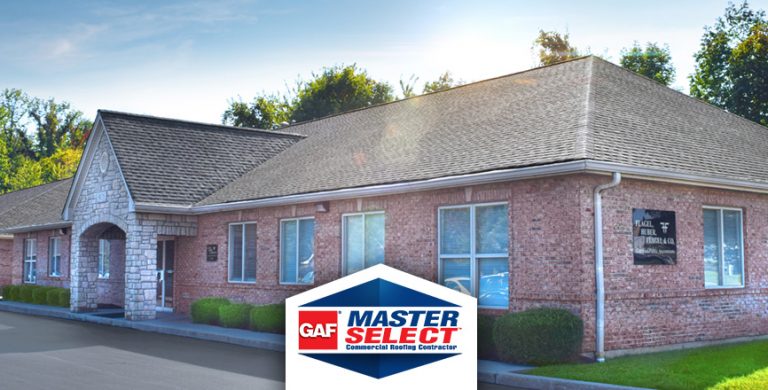The information below is provided to assist you in identifying the signs of aging that can lead to the deterioration of your asphalt roof. It’s essential to be aware of conditions that require maintenance and take steps to ensure that your roof sustains its integrity. If a roof develops leaks, it can result in more costly structural damage. Excess moisture can cause deterioration of the rafters and foundation. If you detect signs of damage, call our expert roofers at Roofing Annex for a roof inspection. We specialize in asphalt roofing and serve the Chicagoland and Greater Cincinnati areas.
The Roof’s Harsh Environmental Conditions
The Effects of the Elements on the Life-cycle of Asphalt Roofs
A roof is exposed to tremendous temperatures from the immense heat of the sun. The sun’s rays can increase the roof’s temperature between 50 and 75 degrees Fahrenheit above the average room temperature. The intensity of the heat is strongest during the afternoon hours. The sun also emits ultraviolet rays that can break down the materials and age an asphalt roof faster. The surface of an asphalt shingle is covered with granules that help protect it from the elements; otherwise, it would degrade very rapidly. In addition, your roof is exposed to moisture, pollution and other physical stress, such as hail, ice, snow and fallen tree limbs, which can further deteriorate and age the roof.
Another cause of aging for an asphalt roof is seasonal changes in the weather. For instance, during the summer months, the roof of your home is subjected to intense heat from the sun, with temperatures reaching 160 degrees Fahrenheit or greater. When a cold front enters the area, it is often accompanied by thunderstorms. The drop in air temperature in combination with the evaporation of rain from the roof can result in a sudden drop in temperature of between 50 and 100 degrees Fahrenheit. This difference in temperature causes the expansion and contraction of the supporting structure beneath the roof and places a strain on the shingles. Over time, as this process recurs, the shingles become fatigued.
This process can occur even more rapidly in the winter. If snow and ice accumulate on the roof, the ice may melt as temperatures increase during the day and then refreeze again as temperatures drop. The repeated refreezing of the ice increases its mass. In addition, as water freezes, it expands and applies enormous force against any structures constraining it. This can cause the roof to warp and leak. Ice build-up can also prevent water from draining properly, causing it to leak into the attic, where it may result in further damage. A roofing contractor from Roofing Annex can provide a roof inspection for your home in the Chicagoland or Greater Cincinnati Area to prevent costly repairs in the long term.
One of the main constituents of roofing shingles is asphalt. Its waterproofing characteristics help maintain the integrity of the roof. The asphalt also secures the granules to the surface of the shingle and adds to its overall strength. Asphalt is a petroleum derivative consisting of oils that contribute to the elasticity and pliancy of shingles. Over time, the oils migrate to the surface of the shingle and are eroded by rain, snow and ice. New oils will then rise to the surface to replace those that were displaced. As this process continues and materials are oxidized from the heat of the sun, the shingles become hardened and brittle.
In addition to exposure to the elements and other external stressors that may shorten the life of your roof, there are internal dynamics that can negatively affect the durability of your roof. Studies have shown that air space with improper ventilation prevents the air from circulating and, as a result, has higher moisture content than in attics with sufficient ventilation. Heat can cause degradation of the shingles while high levels of moisture can result in deck movement and deterioration, which in due course reduce the life of your roof.
There are numerous mechanisms that contribute to the accelerated aging in the life-cycle of asphalt roofs. From the moment the shingles are mounted, the materials of your roof begin the decomposition process. Each day, they are subjected to pounding rain, radiation and widely fluctuating temperatures. Call Roofing Annex for a roofing consultation. We will provide a roof exam and make recommendations to protect your investment.
What Are the Visible Signs of Aging?
If you’re wondering how to determine if your roof has age-related damage, below are a few visible signs that your roof may need repair or replacement.
- Curling may occur as the asphalt hardens and the surface granules are eroded from the shingles. It’s not uncommon to find the granules in your gutters. As the asphalt continues to harden, the layers will commence to contract. Since this process takes place on a microscopic level, it typically goes unnoticed from day to day. However, the asphalt continues to contract while the shingle remains reinforced. As a result, the shingle is placed under stress as it resists the contraction of the coating at the top as well as the bottom. This will eventually cause the shingles to curl at the edges. It should be noted that organic shingles frequently appear to have an excessive amount of curling at the edges. This occurs as a part of the normal weathering process for this type of shingle; therefore, they are not defective
- Surface cracks are another common sign that your roof has begun to deteriorate with age. As the heat and other elements leach the oils from the asphalt, it becomes less flexible. As a result, when it is subjected to stress from thermal shock or movement of the roof deck, cracks may develop in the surface.
- Stains may appear on the roof in the form of dark brown or black marks. They are often thought to be soil, soot or moss. However, they often occur as a result of algae growth. While most roofs are disposed to staining from algae growth, it is more easily seen on light-shaded shingles.
The Aging Process of an Asphalt Shingle
When you first purchased your new asphalt roof, people probably mentioned how much it improved the appearance of your home. Nonetheless, studies have suggested that shingles begin to age immediately upon installation. Evidence has shown that aging proceeds rapidly throughout the course of the preliminary curing process. Concurrently, there may be some loss of granules, blisters might appear, and a minor curling may occur at the edge of the shingles. The curling is typically more prominent in colder temperatures, but the shingles tend to lie flat as the weather grows warmer. Once the initial curing is complete, the shingles begin an extended duration of prolonged aging that continues throughout the majority of their life.
Throughout these middle years, the roof may continue to crack and lose some granules, but it is at a negligible rate. Following this prolonged aging, the materials once again begin to break down much more rapidly. It is at this final stage of the shingles’ life that homeowners usually consider replacing the roof. When it’s time to replace your roof, call Roofing Annex at either our Chicagoland or Cincinnati location. Our roofers use the highest quality shingles with the best manufacturers’ warranties.
Inspecting Your Asphalt Roof
Similar to the way the human body undergoes changes during the aging process, your asphalt roof will go through changes, as well. As a result of the harsh environment that your roof is subjected to, it may exhibit changes in appearance even one year after installation. It is not uncommon to see cracks and blisters while on a ladder during gutter maintenance. Keep in mind that this is an ordinary consequence of weathering that is usually not noticeable when observing the roof from your yard. As long as the roof maintains its integrity and does not leak, there is no cause for concern.
A roof is a significant investment considering that it protects the interior of your home as well as other valuable assets. Although there is no special formula that will halt the aging process for your asphalt roof, a periodic roof inspection can alleviate any worries you may have concerning its condition.
The appearance of the weathering conditions described previously may be indicative of a more severe situation, depending on the type of shingle. For instance, if cracking appears on a three-tab shingle, it may be indicative of weakened reinforcement, which may compromise the roof’s waterproofing ability. This situation requires immediate attention.
Applique-style shingles, however, may develop cracks in the ornamental applique that doesn’t affect reinforcement. This is due to ordinary weathering and does not affect the integrity of the roof. If you have concerns about the condition of your roof, contact Roofing Annex for a roof consultation. We proudly serve the residents of the Chicagoland suburbs and the Greater Cincinnati Area.
The Effect of Granule Loss and Exposed Asphalt
If a large amount of granules are lost from a shingle, it exposes the asphalt to the ultraviolet rays of the sun. This can precipitate failure of the shingle. In the event that a hail storm has struck your roof with enough force to dislodge granules and expose much of the shingles’ surface area, you can anticipate an abbreviated life expectancy for your shingles. You should inquire about coverage with your homeowner’s insurance. In addition, shingles with blisters that expose the asphalt are more susceptible to failure.
Cracks and bare spots are not usually an indication that your shingles are defective. A variety of circumstances that are not within the manufacturer’s control may reduce the life of the shingles.
Roofing Annex maintains an A+ rating with the Better Business Bureau. We service the Cincinnati, Ohio, and the Chicagoland areas. Whether your asphalt roof needs a minor repair or you’re planning a major renovation, we can provide a roof consultation and expert service. Ask us about our available financing options.




